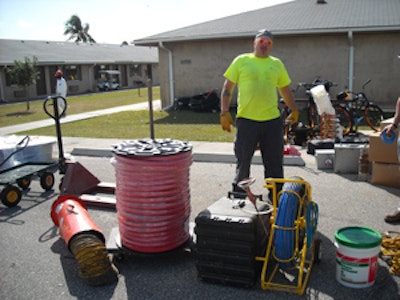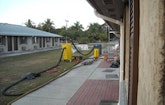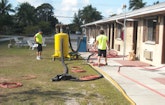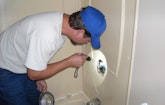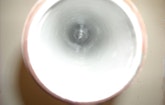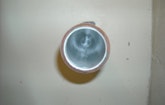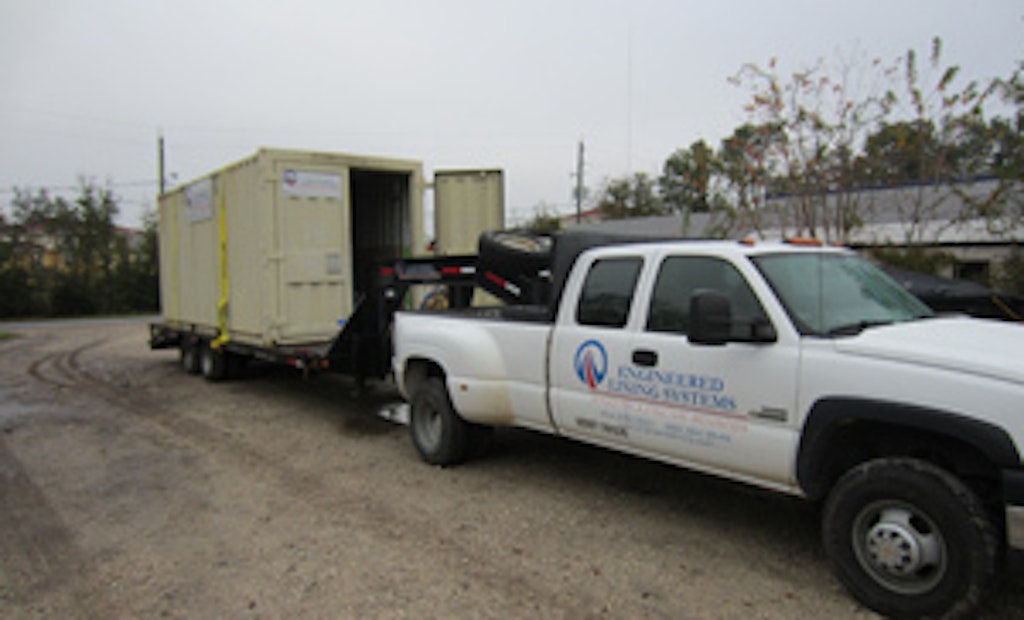Interested in Relining/Rehab?
Get Relining/Rehab articles, news and videos right in your inbox! Sign up now.
Relining/Rehab + Get AlertsDuring normal water-quality testing, officials at the U.S. Navy Atlantic Undersea Test and Evaluation Center (AUTEC) on Andros Island, the Bahamas, discovered high levels of lead in the water at the guest house.
The single-story building with 10 suites also had pinhole leaks in the 3/8- to 2-inch copper pipes supplying hot water. Maintenance crews stopped the drips with repair couplings, but they had no way of preventing the water from absorbing lead from the solder joints as it sat in the pipes for long periods when the house was vacant.
Replacing the lines using traditional methods would take the building out of commission for too long and be too expensive. Jeffery Longshore, project manager for AUTEC Facilities Engineering, flew in three lining contractors to evaluate the project. Engineered Lining Systems, a Jacksonville-based company with a specialty in cured-in-place pipe and structure restoration, won the bid.
“They gave us two weeks to complete the job before VIPs arrived on the base,” says ELS project manager Asa Whitehead. “Small-diameter pipes inside walls can be tricky to line. This also was the first time I had to ship all our tools and supplies. If I forgot something, we would have to do without, since the island has no do-it-yourself center.”
Using blown epoxy lining technology (BELT) from Pipe Shield, ANSI/NSF Standard 61-certified epoxy, and modified equipment, Whitehead’s team finished the project three days ahead of schedule.
Building momentum
As a refresher course, ELS sent Whitehead and technician Mikal Biegner to Toronto to work alongside Pipe Shield employees on a similar project. “There is no such thing as too much training,” says Whitehead. “ELS bases its reputation on making the impossible look easy, and that takes hands-on experience.”
Back home, he spent a week studying the guesthouse plumbing plans, created the packing list, and loaded everything into an 8- by 20-foot steel shipping container. “I brought a lot of extra fittings to accommodate blowouts or other problems we might have,” says Whitehead. “Trying to anticipate everything that could happen took a lot of forethought.”
Larger equipment included Donaldson Torit dust collectors, an IQ 750 cfm (100 psi) trailer-mounted air compressor with thermostatically controlled dryer from Atlas Copco, 40 50-pound bags of Black Beauty coal slag abrasive from READE Advanced Materials, cyclonic dust collection tanks, hoses, and a Brut 300 siphon sandblaster.
ELS transported the container to Cape Canaveral, then an AUTEC barge ferried it to the island. A week later, Whitehead, Biegner, and two other technicians boarded an AUTEC plane for Andros.
Lady Luck smiles
Whitehead’s plan was to complete five suites by the deadline. Workers shut off the water to bathrooms and kitchens, disconnected the fittings, removed wall splashes, and attached couplers to the bathroom cold-water pipes for the air hose. “The only hole I had to cut was in one shower to get around a valve,” he says.
Each room had four 30-foot runs of three cold-water pipes and a separate hot-water feed. Cleaning and lining products exhausted through the kitchen sink’s cold-water line. While the pipes showed little tuberculation, they required sandblasting to score them for the epoxy. It also was necessary to use instrument-quality dry air heated to 120 degrees F to remove traces of moisture.
“We blasted with coal slag, which is softer and not as abrasive as garnet or sand,” says Whitehead. “Our greatest concern was blowing holes in the back side of the numerous elbows, then tearing out the walls to replace them.”
Their fears materialized when they blew through two thin couplings. “We really lucked out because both fittings were in the attic and accessible,” says Whitehead. Workers set up the blower to circulate air in the stuffy space, replaced the bad sections of pipe, and lined through them later.
What the name implies
Engineers at ELS modified the round blasting pot, changing it from an open to a closed system. “Managing dust was a major project, even with all the equipment outside except for the hoses,” says Whitehead. “We laid Uline sticky mats inside the doorways to remove dirt from the soles of our shoes and hung plastic sheets from the door jambs.” The air filtration units ran constantly.
The team began cleaning the pipes with a 10 blast, manually opening and closing the valve on the blasting pot 10 times. Because the Ratech pushrod camera could not inspect pipes smaller than 2 inches, Whitehead evaluated progress by examining the exhaust for foreign material. “Avoiding the removal of too much stock was mainly by sight,” he says. “When the exhaust came out clean, so was the pipe. The most we cleaned was 40 blast.”
Whitehead consulted a chart to determine how much epoxy he needed to travel 30 feet, and how much air pressure to apply to achieve a 15-mil coating. While commercial heating and measuring tools are available, the team improvised, using kitchen measuring cups to measure the epoxy and resin. They kept the small batches warm in a Crockpot.
ELS engineers also designed a cartridge for firing epoxy into small pipes. After Whitehead poured in the mixture and loaded the cartridge in the air gun, he opened a valve and 25 psi shot the liquid through the line.
Ripple effect
Whitehead’s first shot was a learning curve. “We didn’t want any sags,” he says. “They don’t effect usage, but we want a visually perfect lining. Too long a blow forms a skin on the epoxy, then pushes it into ripples.
When Whitehead removed the hose fitting and looked in the pipe, he saw minute signs of rippling. Reducing the blow time from three to two minutes solved the problem.
After the epoxy ambient-cured for 24 hours with both ends of the pipe open, workers attached new shutoffs using SharkBite and Viega ProPress lead-free fittings and ball valves to eliminate soldered joints. They then turned on the water, flushed the lines, and tested the new fittings for leaks. There were none.
Whitehead split his team in half, with two members doing site preparation and restoration and two doing lining. With the first five suites ready for occupancy, work moved along so fast that they were soon completing two per day and finished ahead of schedule.
“It always appears as if there is nothing to a job until you get on site,” says Whitehead. “Making real progress depended on mastering the learning curve and getting the routine down pat. The highly engineered BELT system assured us of quality control and insurance.”
